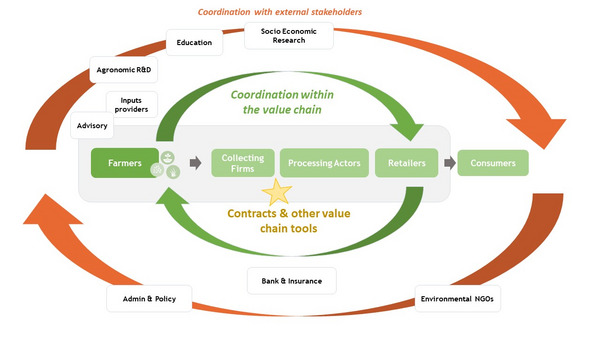The multiple changes required to create and develop new value chains for crop diversification products range from technical to economic, organisational, regulatory and cognitive aspects. The barriers hindering the development of diversified cropping systems are not only diverse, but are also found from the farm level to all other stages of value chains. This is why value-chain coordination is paramount to support diversification, both to set up new value chains or to adapt existing value chains to include diversification products.
The DiverIMPACTS case studies and research have demonstrated that such coordination is needed both within value chains as well as with the external actors.
Within value chains, farmers, intermediaries, processing industries and retailers have to coordinate regarding:
- the expected volume and quality standards of the new crop,
- the strategies to handle risk and variability of production, and
- the approaches to prevent or lower these risks through sharing of information on crop diversification practices, co-creation of knowledge, and collaborative problem solving
See DiverIMPACTS case studies 15, 19 and 24 for examples.
Coordination is also needed with external actors, e.g., upstream actors able to engage in specific input developments, advisory services, R&D, and financial and insurance services (figure 1). This can improve, facilitate and encourage the implementation of new technologies and practices (see case studies 06 and 07 for examples).
In addition to coordination approaches, operational solutions are needed, both in short and long value chains, as tools for framing impactful coordination and sustainable collaboration. An example is innovative contracts which encourage farmers to diversify their cropping systems, and lead to the development of new value chains. Key features of contracts to encourage crop diversification include novel agreements about volume, quality, variability, as well as specific contract duration, risk management, price setting and economic benefits sharing. Such contracts can involve two or more actors, and should take into account the challenges faced by farmers and downstream actors, and incentivise change by ensuring risk sharing during learning phases. Examples of novel arrangements are illustrated by case studies 15, 17, 19, 23. In some cases, contracts may even make actors shareholders.
It must be noted that in early stages of value chains, no formal contracts may be needed, and concrete solutions may take the form of small investments to keep ideas developing. In this case, not only coordination but also trust is especially important to facilitate coordination.
The research results obtained through the DiverIMPACTS regarding coordination and tools for framing collaboration are published in Deliverable 5.6 (see link below). Related recommendations to policy makers have also been summarized in a policy brief (see link below).
Further information
- zenodo.org: DiverIMPACTS Policy Brief: How to support the development of crop diversification? The importance of an approach at the value chain level
- journals.plos.org: Innovating within or outside dominant food systems? Different challenges for contrasting crop diversification strategies in Europe.
- zenodo.org: DiverIMPACTS Policy Brief #2: Recommendations for overcoming barriers to crop diversification towards sus- tainable agriculture .
- zenodo.org: Addressing barriers to crop diversification: key elements of solutions identified across 25 case studies.
- zenodo.org: Consolidated report on logistics and contracts arrangements to enable crop diversification - Deliverable 5.6 (will be available in autumn 2022)
- zenodo.org: Analysis of impact of crop diversification at regional level and for consumers based on selected value chains - Deliverable 6.6(will be available in aumtumn 2022)
- inderscience.com: Product-service systems in direct crop-livestock relationships

 tap and then scroll down to the Add to Home Screen command.
tap and then scroll down to the Add to Home Screen command.